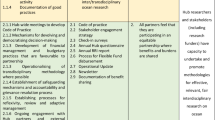Abstract
Partnerships have a crucial role to play in the development agenda. To reach the critical mass required to reduce poverty, there must be more concerted effort, greater collaboration, alignment of inputs, and a leveraging of resources and effort. Understanding the drivers of success and the drivers of failure helps efforts to create and run them.
You have full access to this open access chapter, Download chapter PDF
Similar content being viewed by others
Keywords
In a Word Partnerships have a crucial role to play in the development agenda. To reach the critical mass required to reduce poverty, there must be more concerted effort, greater collaboration, alignment of inputs, and a leveraging of resources and effort. Understanding the drivers of success and the drivers of failure helps efforts to create and run them.

Enhancing Strategic Alliances
A partnership is a formal or informal agreement between two or more partners to work together to achieve common aims. For instance, multilateral and bilateral agencies can compensate for abilities and resources that fall far short of requirements by partnering with nongovernment organizations, both national and international. Such organizations are able to form close linkages and engender ownership and participation. Their consultative and participatory methods note and express stakeholder views that might otherwise not be entertained. This enables them to identify up-and-coming issues, respond rapidly to new circumstances, and experiment with innovative approaches. Therefore, partnering can improve the relevance, effectiveness, efficiency, and sustainability of operations. However, few would-be partners fully consider the opportunities and constraints that are associated with the creation and running of partnerships. A frequent cliché relates to the need to avoid duplication and overlap. Habitually, extant memoranda of agreement are worded loosely.
Drivers of Success
The drivers of success include:
-
Agreement that a partnership is necessary;
-
Esteem and trust between different interests;
-
The leadership of a respected individual (or individuals);
-
The commitment of key interests developed through a clear and open process;
-
The development of a shared vision of what might be achieved;
-
Shared mandates or agendas;
-
The development of compatible ways of working, which presupposes organizational flexibility;
-
Good communication, perhaps with the help of facilitators;
-
Collaborative decision-making, with a commitment to achieving consensus;
-
Effective organizational management; and
-
Time to build the partnership.
Drivers of Failure
In opposition, the drivers of failure include:
-
A history of conflict among key interests;
-
One partner manipulates or dominates;
-
Unrealistic goals and objectives;
-
Differences of philosophy and ways of working;
-
Poor communication;
-
An unequal and unacceptable balance of power and control;
-
An absence of common interests;
-
Hidden or irreconcilable agendas; and
-
Financial and time commitments that outweigh potential benefits.
Guidelines for Managers
In general:
-
Informal partnerships work best when a project is specific and achievable.
-
Where the project is complex and spans several years, it may be necessary to create formal partnership structures for decision-making.
-
It is not easy to tackle a wide range of issues through an informal partnership. It is better to address such matters through consultations.
-
Simply setting up a partnership structure does not solve all problems. Partners still need to clarify the joint goal and objective, values, and interests, among others.
-
Partnerships do not have to be equal but the partners do need to feel that they are involved to an appropriate degree.
Guidelines for Project Officers
The following suggests how project officers can make a start:
-
Clarify the goal and objective behind forming a partnership.
-
Identify the stakeholders and the key interests that can help or hinder the development of a project.
-
Consider who one really needs as a partner and who would really want to be a partner: some stakeholders may only want to be consulted.
-
Before approaching potential partners, make sure that you have support and agreement about working with others.
-
Make informal contact with partners to understand their values and interests before formulating formal proposals.
-
Communicate with your partners in a language they will understand, focusing on what they may want to achieve.
-
Plan the partnership process over time.
-
Use a range of methods to gather people in workshop sessions as well as in formal meetings.
-
Encourage ideas from partners because ownership leads to commitment.
-
Be trustworthy. One of the main barriers to creating and running successful partnerships lies in the attitudes that people bring to the process. To develop trust , it is necessary to draw out and deal with suspicions from past contacts; be open about what one is trying to achieve and about problems; be prepared to make mistakes and to admit to them; and deliver what one promises.
Creating and Running Partnerships
Since partnerships are formal or informal agreements to work together to achieve common aims, there can be no recipe for success. Whatever the working arrangements, and whatever phase of the partnership one is in, there will be problems: people will not read documents or come to meetings, colleagues will fail to deliver on promises, different interest groups will have conflicting aims, deadlines will be missed, and the champions behind the partnership may become scapegoats. Notwithstanding, the need to enhance strategic alliances calls on managers and project officers to:
-
Advertise country strategies and programs and details of loan, grant, and technical assistance projects through media, such as the Internet, newsletters, and public meetings, and take care to give evidence of strategic integration.
-
Map potential partners for strengths, weaknesses, opportunities, and threats.
-
Understand the priorities and skills of potential partners.
-
Develop a partnership structure based on a clear purpose, trust , and agreement on responsibilities and accountability.
-
Identify champions and communicate with them frequently.
-
Build partner confidence through early participation in project work.
-
Accept that partnerships need long-term support and make abilities and resources available.
-
Develop a forward strategy for partnerships.
-
Ensure appropriate monitoring of progress by the partnership.
The existence of commonalities of interest and memoranda of understanding offers only the promise of partnership. The onus of enhancing strategic alliances is on managers and project officers to integrate partnerships in annual operating outputs in the myriad ways that the multifarious nature of such associations dictates.
Author information
Authors and Affiliations
Corresponding author
Rights and permissions
The opinions expressed in this chapter are those of the author(s) and do not necessarily reflect the views of the Asian Development Bank, its Board of Directors, or the countries they represent.
Open Access This chapter is licensed under the terms of the Creative Commons Attribution-NonCommercial 3.0 IGO license (http://creativecommons.org/licenses/by-nc/3.0/igo/) which permits any noncommercial use, sharing, adaptation, distribution and reproduction in any medium or format, as long as you give appropriate credit to the Asian Development Bank, provide a link to the Creative Commons license and indicate if changes were made.
Any dispute related to the use of the works of the Asian Development Bank that cannot be settled amicably shall be submitted to arbitration pursuant to the UNCITRAL rules. The use of the Asian Development Bank’s name for any purpose other than for attribution, and the use of the Asian Development Bank’s logo, shall be subject to a separate written license agreement between the Asian Development Bank and the user and is not authorized as part of this CC-IGO license. Note that the link provided above includes additional terms and conditions of the license.
The images or other third party material in this chapter are included in the chapter’s Creative Commons license, unless indicated otherwise in a credit line to the material. If material is not included in the chapter’s Creative Commons license and your intended use is not permitted by statutory regulation or exceeds the permitted use, you will need to obtain permission directly from the copyright holder.
Copyright information
© 2017 Asian Development Bank
About this chapter
Cite this chapter
Serrat, O. (2017). Creating and Running Partnerships. In: Knowledge Solutions. Springer, Singapore. https://doi.org/10.1007/978-981-10-0983-9_2
Download citation
DOI: https://doi.org/10.1007/978-981-10-0983-9_2
Published:
Publisher Name: Springer, Singapore
Print ISBN: 978-981-10-0982-2
Online ISBN: 978-981-10-0983-9
eBook Packages: Business and ManagementBusiness and Management (R0)




